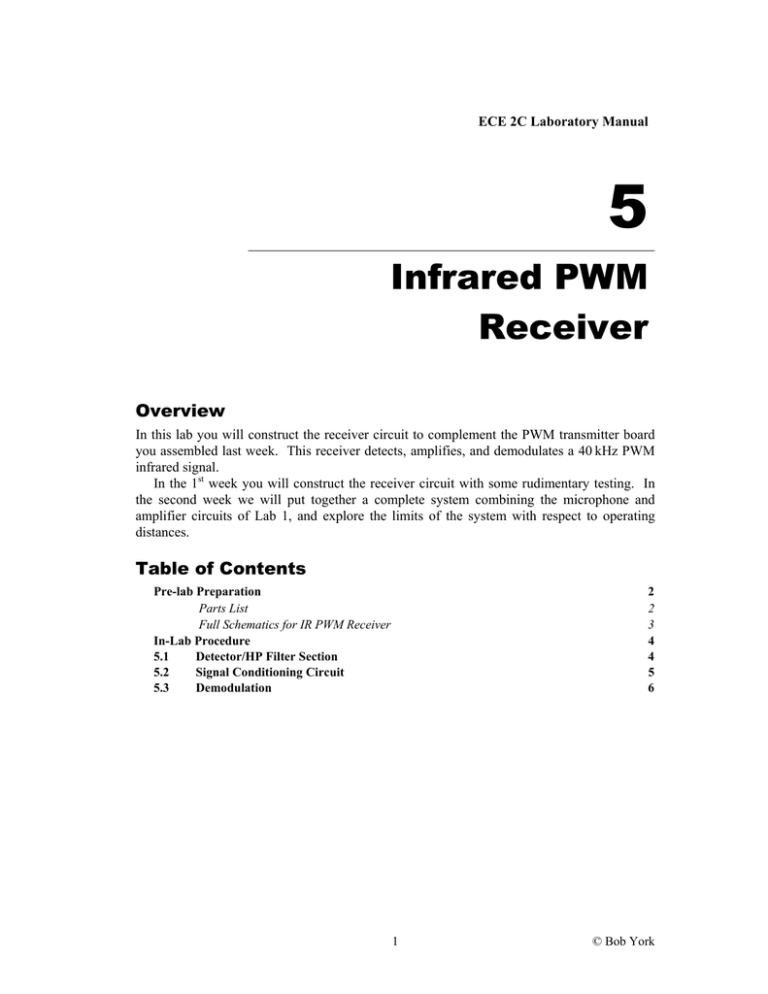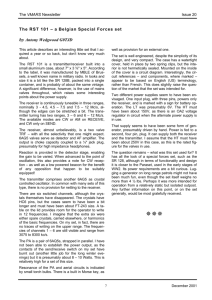Infrared PWM Receiver
advertisement

ECE 2C Laboratory Manual 5 Infrared PWM Receiver Overview In this lab you will construct the receiver circuit to complement the PWM transmitter board you assembled last week. This receiver detects, amplifies, and demodulates a 40 kHz PWM infrared signal. In the 1st week you will construct the receiver circuit with some rudimentary testing. In the second week we will put together a complete system combining the microphone and amplifier circuits of Lab 1, and explore the limits of the system with respect to operating distances. Table of Contents Pre-lab Preparation Parts List Full Schematics for IR PWM Receiver In-Lab Procedure 5.1 Detector/HP Filter Section 5.2 Signal Conditioning Circuit 5.3 Demodulation 2 2 3 4 4 5 6 1 © Bob York 2 Infrared PWM Receiver Pre-lab Preparation You have two weeks to complete this lab. Read through the lab experiment to familiarize yourself with the components and assembly sequence, and complete the calculations below. Before coming to the lab, each group should obtain a parts kit from the ECE Shop. Bring your solder-less breadboard, tools, & wire jumpers, as well as the IR transmitter from Lab 4 and the power-supply from ECE 2B. Required calculations: □ Determine the maximum capacitance C8/C9 in the 2nd-order HP filter stage that will give at least 26dB of rejection at 120 Hz. What is the resulting HP cutoff frequency? C8/C9=______________uF □ f HP =______________Hz For a peak photodiode current I photo , find an expression for the signal voltage after the first four op-amp stages (i.e. at the output of U3D). Express your answer in terms of R12-R20. Vout = _______________________________________________________________ Parts List Qty Description Circuit Semiconductors 2 Op-Amp, LF347N (DIP-14) 4 DIODE, 1N4148 2 n-ch JFET, 2N5485 U3, U4 D1-D4 Q3,Q4 Passives 8 RESISTOR, 1kΩ 10% 1/4W 2 RESISTOR, 2.2kΩ 10% 1/4W 3 RESISTOR, 4.7kΩ 10% 1/4W 4 RESISTOR, 47kΩ 10% 6 RESISTOR, 10kΩ 10% 1/4W 2 RESISTOR, 100kΩ 10% 1 POTENTIOMETER, 2k Ω 1 1 2 2 1 8 CAPACITOR, CAPACITOR, CAPACITOR, CAPACITOR, CAPACITOR, CAPACITOR, 2 CAP_ELECTROLIT, 100µF 20% © Bob York R13, R15, R17, R18, R19, R21 R14, R16, R20 R12, R25 R24, R26-29 R22 R23 10pF 20% 0.001µF 10% (low-volt ceramic) 0.0022µF 10% (low-volt ceramic) 0.047µF 10% (low-volt ceramic) 0.01µF 20% 0.1µF 20% 2 C7 C12 C13, C14 C8, C9 C5, C6, C10, C11, C15, C16 3 Pre-lab Preparation Full Schematics for IR PWM Receiver Figure 5-1 – Schematic for the Analog Infrared PWM Receiver. 3 © Bob York 4 Infrared PWM Receiver In-Lab Procedure At this stage you should have your transmitter circuit hardwired on a vectorboard. For most of this lab, you will need to set up your transmitter with its own power supply for testing. 5.1 Detector/HP Filter Section In the previous lab we discussed a basic circuit topology for detecting an infrared pulse train using a photodiode. The circuit shown in Figure 5-2 is essentially the same trans-impedance amplifier circuit that we discussed, followed by an additional noninverting amplifier. Since the gain-bandwidth product of our op-amps is somewhat limited, we must use a number of small-gain sections rather than a single high-gain section. However, for preliminary testing with the transmitter close by, gain will not be an issue so we will construct our circuits with a rather low-gain to start, and then substitute different values for the critical resistors later. Also, we note that we have chosen the LF347 quad opamp IC since we will end up using seven different op-amp stages in this receiver. □ □ □ C7 10pF R12 IR Detector and gain stage VDD C5 0.1µF IRD1 BPV23F U3B LF347N C6 A C U3A LF347N 0.1µF VSS VSS R13 R14 1kΩ Figure 5-2 – First two gain stages. Construct the circuit in Figure 5-2 using the LF347. Consult the datasheets on the course web site for the pin assignments for the LF347 and the photodiode. Here Vdd is the positive supply and Vss is the negative supply. The circuits in this lab were designed to operate at +/- 12 V, but should work reasonably well at lower voltages as well. Be sure to include the bias decoupling capacitors. Start with R12=47 kΩ and R14=1 kΩ. Test the circuit using your transmitter board, which in the absence of a modulating signal should be set up to produce a 40 kHz, 50% duty-cycle pulse train. Depending on the proximity and alignment of your transmitter, you may need to increase or decrease the values of the critical gain resistors R12 and R14. Verify that the circuit is functioning properly before proceeding. You may need to observe the output using AC coupling on the oscilloscope if there is a large DC offset in the waveform. Now, turn off your transmitter and expand the vertical scale on the oscilloscope, with DC coupling for the input signals. Adjust the time-base for ~5 ms/division. You should see a noisy waveform, possible with some 120Hz noise superimposed on a DC level. This is the interference from room lights and sunlight. To deal with the possibility of noise and interference obscuring our signal, we need only remember that our desired signal is a pulse train at 40 kHz, and that all of the information is encoded in the timing of the edge transitions in this pulse train. So we can insert a high-pass filter to pass the desired high-frequency pulse train, rejecting low-frequency noise. That is © Bob York 4 5 Signal Conditioning Circuit the purpose of the next two sections in the receiver. Together the two stages involving U3C and U3D form a second-order high-pass filter, and also provide some additional gain. □ □ Add the next two stages as shown in Figure 5-3. Use capacitor values equal to or greater than the values you calculated in the pre-lab section for C8/C9. For the gain resistors R16 and R20, you could again use 1kΩ resistors if your transmitter is in close proximity. Power-on the transmitter and receiver and observe/record the output waveform. 2nd-order High-pass (interference-rejection) and gain R19 R15 R16 R20 1kΩ 1kΩ C9 C8 U3D U3C LF347N R18 1kΩ LF347N R17 1kΩ Figure 5-3 – 2nd-order high-pass/gain stage. 5.2 Signal Conditioning Circuit At this point in the receiver we should have a nicely amplified signal that is a reasonably good representation of the transmitter signal and is relatively free of noise and interference. The problem now is that the amplitude of the signal will change as the transmitter is moved closer or further away. This is undesirable. A simple solution is a threshold detector circuit with a clamped output level as shown in Figure Threshold 5-4. This circuit produces an output level of 0.6V detector/limiter (signal conditioning) above or below the reference level at the “+” D2 terminal, depending on which way the signal crosses through this level. 1N4148 D1 □ □ □ VDD Construct the circuit shown in Figure 5-4. 1N4148 Note that we need to use a new LF347 chip at R22 R21 this stage, since we have already used up all 100kΩ the op-amps on U3. Start by adding your bias 1kΩ U4A connections and de-coupling capacitors before R23 LF347N adding any of the other components in this C10 2kΩ 0.1µF circuit. Key=A 25% Start with the trimpot R23 adjusted for 0V R23 sets crossing threshold output on the “+” pin. Now turn on the transmitter and observe the output waveform. Figure 5-4 – Signal conditioning circuit. You should see a nice square wave, with amplitude that doesn’t change as the transmitter is moved away. Now turn off the transmitter and observe the output. Can you see what is happening? In this case, any noise in the system can still trigger the threshold detector. We need to adjust the reference level R23 above this noise floor to resolve the problem. Adjust R23 until the output level remains constant. Depending on your circuit and surroundings, a reference level of 100-200mV on the “+” pin should be sufficient. 5 © Bob York 6 Infrared PWM Receiver Ideally what we’d prefer to do here is insert a zero-crossing detector that has some hysteresis, like a Schmitt trigger circuit. As you may recall from last quarter, these circuits can be constructed using comparators. However, in receiver circuits with very high gain and width bandwidths like ours, the fast, large-signal switching transients associated with comparators can cause problems when the switching transients feed back into the input stages through the power supply rails, often leading to a parasitic oscillation in the circuit. So for the sake of simplicity and stability, we chose a simple (though crude) solution. 5.3 Demodulation The last step is to demodulate the signal, which can be easily done using a low-pass filter to remove the 40 kHz pulse train. This is shown in Figure 5-5. There is a DC blocking capacitor at the input to remove the DC level associated with the non-zero crossing threshold in the signal conditioning circuit. C12 3rd-order Low-pass (demodulation) R25 R29 R28 10kΩ 10kΩ LF347N U4C R26 10kΩ C13 2.2nF 47kΩ 1nF VSS C15 DC Block 0.1µF R27 10kΩ U4B R24 C11 10kΩ 0.1µF LF347N C16 C14 2.2nF 0.1µF VDD Figure 5-5 – PWM Demodulator □ □ □ Construct the filter in Figure 5-5. Your receiver is now complete. Now set up the transmitter with a 1 kHz sinusoidal modulation signal from the bench function generator, and observe the output of the receiver system. Start with a low-level modulating signal; you should have an estimate for an appropriate modulation level from your work in Lab #4. You should be able to observe the 1 kHz tone, which will have some residual amount of the 40 kHz carrier superimposed. Try varying the modulation amplitude and observe the effects of over-driving this input. Sweep the frequency of the function generator to estimate and record the low- and highfrequency cutoff points. These define the bandwidth of your communication link. In you lab write-up you should be able to identify the parts of the circuit that determine these cutoff frequencies. Congratulations! You have now completed the 1st week of Lab 5 © Bob York 6

